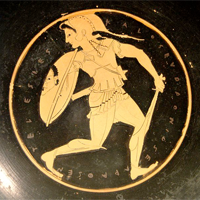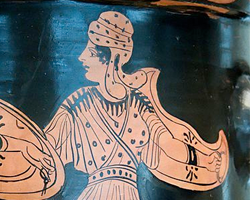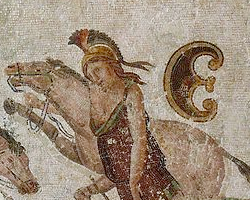
This page created 31 August 2014, and last modified: 10 October 2015 (unit derivation section updated)

The Menapii is listed (18.13 in Ingo Maier's numbering scheme) as the second-most most senior of the legiones comitatenses under the Magister Militum per Thracias. Its shield pattern (16#3) as shown in various manuscripts, under the matching label (16.c) Menapii, is as below:

The shield pattern has a white main field; a dog at the bottom of the shield in light brown, facing left (right in B, which being printed reverses all facings), and in the centre, an unusual design in red, which looks like a circle with two deep lobes cut out at approximately the 11 o'clock and the 1 o'clock positions. This would appear to be a mythological Amazonian shield.

|

|

|
|
|
|
|
|
|
|
|
As can be seen from the above, Amazons, despite being mythologically located to the north-east, were first conceived by the Greeks as being armed like contemporary Greek warriors; in the 6th century, this meant a heavy Argive shield as depicted above-left. After the Persian invasions, however, Amazons were depicted with light crescent-shaped peltae as carried by the appropriately-located Scythians, although they frequently were shown with a slight "bump" in the middle of the convex section that real peltae did not seem to share, as shown in the middle picture above. This bump seems to have steadily grown, so that by the start of the 3rd century, it could be shown as a central "stalk", as shown above-right.
Five other units have patterns bearing the same central amazonian pelta device: the unit that is said to be (12.28) the Sagittarii seniores Orientales, under the Magister Militum Praesentalis II, and, under the Magister Militum per Orientem, the Prima Armeniaca (15.26), the Secunda Armeniaca (15.27), the Secunda Felix Valentis Thebaeorum (15.23), and the Prima Flavia Theodosiana (15.24). All six can be compared below, using the patterns taken from the Parisian manuscript:

That four of these are found in the geographically appropriate oriental command, and the fifth is (perhaps coinicidentally?) ascribed an oriental name raises the prospect that the sixth, the Menapii, was also associated with the command at one point, but was later transferred west, to that of the Magister Militum per Thracias.
The name Menapii derives ultimately from the Belgic tribe the Menapii, no doubt via the Roman district into which part of their territory was later included, the Civitas Menapiorum; this administrative unit later became the Civitas Turnencensium. The Menapii was presumably raised there, or had been stationed there before joining one of the field armies. In the western half of the empire, the senior-most legiones comitatenses is the Menapii seniores (98/9.98; also referred to as the Menapes seniores); it is unlikely the eastern unit is the otherwise unattested Menapii iuniores, as any iuniores unit would be expected to be lower ranked: the highest-ranked iuniores comitatenses legion in the east, the Pannoniciani iuniores (18.26) is ranked a lowly 15th out of 20 units infantry in the list of the Magister Militum per Thracias. Further, there are many instances of trios of units in the Notitia being divided along the lines of "X seniores" and "X iuniores" in the west, and plain "X" in the east; the Menapii iuniores may have simply been destroyed at some point (note that the western Dux Mogontiacensis is noted as commanding a Praefectus militum Menapiorum (156/8.3) at Tabernas; presumably Tres Tabernas, modern Rheinzabern in the Rhein-Palatinate, Germany). As might be expected, the shield pattern of the western Menapes seniores is completely different to that of the eastern Menapii.
Given the plethora of legions (to say nothing of legionary detachments) that were stationed along the Rhine over the centuries, it mightd appear to be futile to try and discern which (former) legion was the forbear of the Menapii based on deployment location. Nonetheless, since other legions with names deriving from the general area appear to derive from the time of Constantine I just before his invasion of Italy in 312 (notably the Divitenses seniores, 98/9.23), the four main legions stationed in Germany at the time appear to be the most likely candidates: Legiones I Minervia, VIII Augusta, XXII Primigenia, and XXX Ulpia Traiana.

Return to the Notitia alphabetical unit list page.
Return to my Notitia index page.